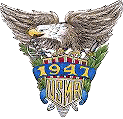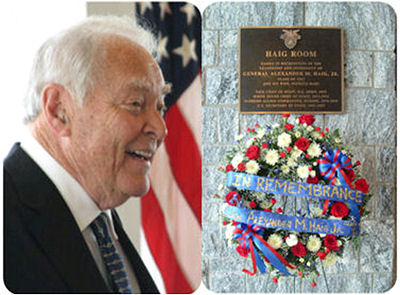The Dedication of the Alexander M. Haig, Jr. Room
ASSEMBLY JANUARY / FEBRUARY 2009
Family, colleagues, and a contingent of classmates joined to honor of GEN (Ret.) Alexander Meigs Haig, Jr. ’47, and his wife Patricia, and witness the dedication of the Haig Room on the sixth floor of the new Jefferson Hall Library on the morning of27 October 2008.
At a welcoming dinner for the Haig family hosted the previous night by the
West Point Association of Graduates at Herbert Hall, GEN and Mrs. Haig were recognized for
their generous gift in support of academic programs at West Point by being inducted into the
Eisenhower Society for Lifetime Giving. Guests included GEN Haig’s younger brother, Fr. Frank
Haig, a Jesuit priest; sons Brian ’75 and wife Lisa, and Alex with wife Wendy; daughter Barbara;
and numerous grandchildren.
During his introduction of GEN Haig at the dedication, Superintendent LTG Buster Hagenbeck
’71 mentioned some meetings they had had earlier with cadets. In response to some questioning
looks, the Superintendent explained to the cadets that, when GEN Haig referred to discussions
with “Henry, Jerry, and Ron,” he meant former Secretary of State Kissinger and Presidents
Ford and Reagan.
In his presentation, Haig joked about not standing at the top of his class or being able to do
everything “perfectly” like MacArthur, but he became serious when he spoke of the primary responsibility
of military leaders being to the American people. This responsibility requires them to
speak out when they do not agree with policies; and he admitted that he had been required to do
so on three significant occasions.
The dedication opened with a prayer from Rev. Joseph Easterbrook,
representing the Archdiocese of the Military Services, and ended with a prayer by Haig’s
brother Frank. Before moving to the Black, Gold & Gray Room of Washington Hall for lunch,
GEN and Mrs. Haig were escorted to the poop deck and acknowledged by the Corps with a
cheer and sustained applause.
The service of former Secretary of State GEN (Ret.) Alexander M. Haig, Jr., began following
World War II. As an aide de camp in the Korean War, he was awarded two Silver Stars and a
Bronze Star for Valor. During 1962–65, he initially served as Military Assistant to Secretary of the
Army Cyrus Vance, and subsequently, as Special Assistant to both the Deputy Secretary and Secretary
of Defense Robert McNamara. As G-3 of the 1st Infantry Division and commander of the
1st Battalion, 26th Infantry, in Viet Nam, he was awarded the Distinguished Service Cross and
Purple Heart, to name only two of his decorations. After time as a regimental tactical officer and
assistant commandant at West Point, in January 1969, he was selected as the Senior Military Advisor
to the Assistant to the President for National Security Affairs, Dr. Henry Kissinger, and later
became Deputy Assistant to the President for National Security Affairs. He served as personal
emissary of President Nixon to negotiate the Viet Nam ceasefire and the return of U.S. prisoners
of war and also oordinated Nixon’s historic visit to China. While Vice Chief of Staff of the Army,
Nixon named him White House Chief of Staff, at which time he retired from the Army.
.
In October 1974, President Ford recalled Haig to active duty as Commander in Chief,
U.S. European Command. Two months later, he also became Supreme Allied Commander
in Europe. Retiring from the Army again in 1979, in January 1981, he was sworn in as the
59th U.S. Secretary of State under President Ronald Reagan.
The Haig Room measures approximately 50 x 65 feet and houses the 1822 Thomas
Sully portrait of President Thomas Jefferson, along with portraits of President James
Monroe and Joseph Gardner Swift, Class of 1802 and first graduate of West Point. _



